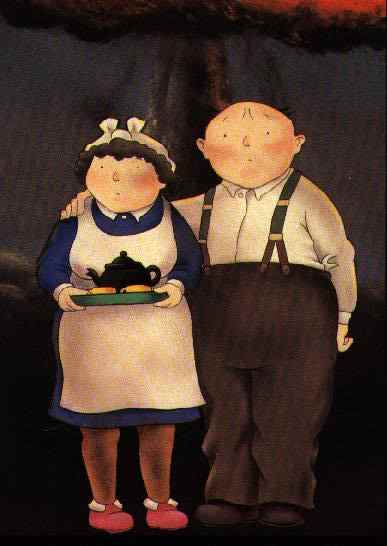Threads was a horrifyingly
realistic film made in 1984 about how nuclear war affects two families from
Sheffield. It includes references to Protect and Survive and extracts from
some of the Public Information Films. A detailed synopsis of the film, including
stills can be found on Patrick Beans' Threads
site.
Several bands were influenced
by these UK civil defence campaigns, most notably Jethro
Tull who included a track called "Protect and
Survive" on their 1980 album "A". The
interesting lyrics
to this song can be found on The Annotated
Jethro Tull Lyrics Page.
The group Big
Country also made reference to Protect and Survive on
their track "1000
Stars" (1983).
Frankie goes to
Hollywood included the voice of Patrick Allen who
narrated the Action After Warnings
and Casualties Public
Information Films, on their track "Two
Tribes" (1984). This includes the following
lines:
"If any member of the family should die whilst in
the shelter from contamination,
Put them outside, but remember to tag them first for
identification purposes.
Mine is the last voice that you will ever hear, do not be
alarmed."
The elements of black-humour in Protect and Survive
are not hard to find and these supplied many 80s
alternative comedians with the material for some of their
cold-war political humour. The
Young Ones episode "Bomb"
written by Ben Elton includes the casts following
responses to a nuclear Bomb appearing in the kitchen:
NEIL: Seriously, we ought to do something about this
bomb! I'm going upstairs to get the incredibly helpful
and informative "Protect and Survive" manual!
Nobody better touch this while I'm gone!
RICK: What are you doing?
[Neil is reading his survival manual while painting
himself white with a paintbrush]
NEIL: Oh, painting myself white to deflect the blast!
RICK: That's great, isn't it, Racial discrimination, even
in death! What are these? [indicates a few lunchbags on
the table]
NEIL: Oh, sandbags!
[The table now has a drape over it saying, 'KEEP OUT,
FALLOUT'. Mike enters carrying food in both hands]
MIKE: Neil, where's the table?
NEIL: Oh, good. You got the provisions.
MIKE: Yeah
NEIL: No, not on the roof man!, put it in the food zone!
Anyway, it's got to be tinned if it's going to survive
ten years of fallout!
Reading Protect and Survive as a teenager in the 80s
filled me with a feeling of cold dread, and I wonder what
could have been going through the minds of the people who
created it? It's hard to believe that less than twenty
years ago this seemed like an all to realistic picture of
our imminent future:

The overall effect of this booklet is very disturbing.
Did the government believe a nuclear war was survivable
when they produced these booklets and plans? Did that
make nuclear war more likely by upsetting the MAD (Mutually
Assured Destruction) balance between East and West?
Here are some more disquieting highlights:
"Even the safest room in your home is not safe
enough" - ah, I see, so, er....what am I supposed to
do then?
Where am I supposed to get a box of dry sand for my
survival kit from (my local DIY store has had a bit of a
run on sand and boxes since the end-of the world was
announced), and supposing I do get hold of the specified
materials how on Earth do I use them to wash plates?
There is nothing in the book about how to defend your
shelter from the rampaging hordes without sand-boxes, in
fact you are told "If there is time, help neighbours
in need...", oh yes, a very British a apocalypse was
being planned for us.
We are constantly told to "Keep the radio tuned
for Government advice and instructions."
"DO NOT GO OUTSIDE until the radio tells you it
is safe to do so." - what if my radio never tells me
anything ever again?
"You should receive radio instructions on
what to do next." - if you don't then civilisation
has collapsed, government is no more, you are now on your
own, good luck!
Finally we are given a little reassurance: "When
you hear the ALL-CLEAR this means there is no longer an
immediate danger from air attack and fall-out and you
may resume normal activities." - if you consider
stepping over piles of rubble and bodies whilst searching
for uncontaminated tinned food normal!
More interesting thoughts about the effects of Protect
and Survive and nuclear paranoia on 80s British culture
can be found on this site
by Andrew Rilstone.
Copyright 2002 © George Coney
Last updated February 2002
Send mail to atomic@cybertrn.demon.co.uk
|




